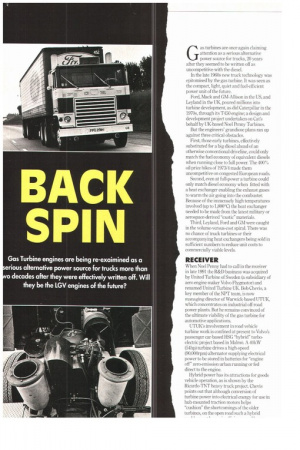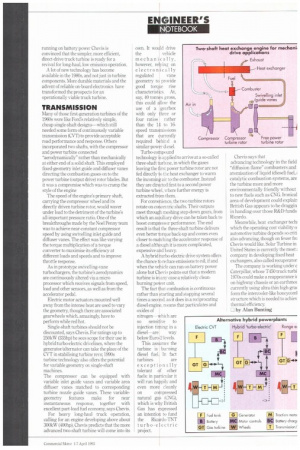ACK SPIN
Page 28

Page 29

If you've noticed an error in this article please click here to report it so we can fix it.
Gas Turbine engines are being re-exaimined as a erious alternative power source for trucks more than o decades after they were effectively written off. Will they be the LGV engines of the future?
Gas turbines are once again claiming attention as a serious alternative power source for trucks, 20 years after they seemed to be written off as uncompetitive with the diesel.
In the late 1960s new truck technology was epitomised by the gas turbine. It was seen as the compact, light, quiet and fuel-efficient power unit of the future.
Ford. Mack and GM-Allison in the US, and Leyland in the UK, poured millions into turbine development, as did Caterpillar in the 1970s, through its T450 engine; a design and development project undertaken on Cat's behalf by UK-based Noel Penny Turbines.
But the engineers' grandiose plans ran up against three critical obstacles.
First, those early turbines, effectively substituted for a big diesel ahead of an otherwise conventional driveline, could only match the fuel economy of equivalent diesels when running close to full power. The 400% oil price hikes of 1973/4 made them uncompetitive on congested European roads.
Second, even at full-power a turbine could only match diesel economy when fitted with a heat exchanger enabling the exhaust gases to warm the air going into the combuster. Because of the immensely high temperatures involved (up to 1,800°C) the heat exchanger needed to be made from the latest military or aerospace-derived "exotic" materials.
Third, Leyland, Ford and GM were caught in the volume-versus-cost spiral. There was no chance of truck turbines or their accompanying heat exchangers being sold in sufficient numbers to reduce unit costs to commercially viable levels.
RECEIVER
When Noel Penny had to call in the receiver in late 1991 the R&D business was acquired by United Turbine of Sweden (a subsidiary of aero engine maker Volvo Flygmotor) and renamed United Turbine UK. Bob Chevis, a key member of the NPT team, is now managing director of Warwick-based UTIJK, which concentrates on industrial off-road power plants. But he remains convinced of the ultimate viability of the gas turbine for automotive applications.
UTUK's involvement in road vehicle turbine work is confined at present to Volvo's passenger car-based HSG "hybrid" turboelectric project based in Malmo. A 40kW (54hp) turbine drives a high-speed (90,000rpm) alternator supplying electrical power to be stored in batteries for "engine off" zero-emission urban running or fed direct to the engine.
Hybrid power has its attractions for goods vehicle operation, as is shown by the Ricardo-TNT heavy truck project. Chevis points out that although conversion of turbine power into electrical energy for use in hub-mounted fraction motors helps "cushion" the shortcomings of the older turbines, on the open road such a hybrid running on battery power Chevis is convinced that the simpler, more efficient, direct-drive truck turbine is ready for a revival for long-haul, low emission operation.
A lot of new technology has become available in the 1980s, and not just in turbine components More durable materials and the advent of reliable on-board electronics have transformed the prospects for an operationally viable truck turbine.
TRANSMISSION
Many of those first-generation turbines of the 1960s were like Ford's relatively simple, cheap single-shaft designs—which still needed some form of continuously variable transmission (cv-r) to provide acceptable road performance and response. Others incorporated two shafts, with the compressor and power turbine connected "aerodynamically" rather than mechanically at either end of a solid shaft. This employed fixed-geometry inlet guide and diffuser vanes directing the combustion gases on to the power turbine (output drive) rotor blades. But it was a compromise which was to cramp the style of the engine
The speed of the engine's primary shaft, carrying the compressor wheel and its directly driven turbine rotor, would waver under load to the detriment of the turbine's all-important pressure ratio. One of the breakthroughs made by the Noel Penny team was to achieve near-constant compressor speed by using swivelling inlet guide and diffuser vanes The effect was like varying the torque multiplication of a torque converter to maximise its efficiency at different loads and speeds and to improve throttle response.
As in prototype swivelling-vane turbochargers, the turbine's aerodynamics are continuously altered via a micro processor which receives signals from speed, load and other sensors, as well as from the accelerator pedal.
Electric motor actuators mounted well away from the intense heat are used to vary the geometry; though there are associated gearwheels which, amazingly, have to perform while red hot.
Single-shaft turbines should not be discounted, says Chevis. For ratings up to 250kW (335hp) he sees scope for their use in hybrid turbo-electric drivelines. where the generator/alternator can take the place of the CVT in stabilising turbine revs: 1990s turbine technology also offers the potential for variable geometry on single-shaft machines.
The compressor can be equipped with variable inlet guide vanes and variable area diffuser vanes matched to corresponding turbine nozzle guide vanes These variablegeometry features make for near instantaneous response, together with excellent part-load fuel economy, says Chevis.
For heavy long-haul truck operation, calling for an engine developing above about 300kW (400hp), Chevis predicts that the more advanced two-shaft turbine will come into its
own. It would drive the vehicle mechanically, however, rely imz. on electronically
regulated vane geometry to provide good torque rise characteristics. At, say. 40 tonnes gross, this could allow the use of a gearbox with only three or four ratios rather than the 14 to 16speed transmisi,ions that are currently required behird a similar-power cf.esel.
Turbo-compound technology is applied to arrive at a so-called three-shaft turb ate, in which the gases leaving the first power turbine rotor are not fed directly to t l-•.e heat exchanger to warm the incoming air to the combuster. Instead they are directed first to a second power turbine wheel, where further energy is extracted from them. •
For convenience, the two turbine rotors rotate on concer:tric shafts Their outputs meet through meshing step-down gears, from which an auxiliary drive can be taken back to boost compressor performance. The end result is that the three-shaft turbine delivers even better torque back-up and comes even closer to matching the accelerator response of a diesel although it is more complicated, expensive and heavy.
A hybrid turbo-electric drive system offers the chance to reduce emissions to nil, if and when the vehicle can run on battery power alone but Chevi F, points out that a modern turbine is in any case a relatively cleanburning power unit.
The fact that combustion is continuous rather than starting and stopping several times a second. as it does in a reciprocating diesel engine, means that particulates and oxides of nitrogenwhich are so sensitive to injection timing in a diesel—are way below Euro-2 levels.
This assumes the turbine is burning diesel fuel. In fact turbines are exceptionally tolerant of other fuels: in particular it will run happily and even more cleanly on compressed natural gas (CNG), which is why British Gas has expressed an intention to fund the Ricardo-TNT turbo-electric project advancing technology in the field "diffusion flame" combusters and atomisation of liquid (diesel) fuel, ; catalytic combustion systems, are the turbine more and more environmentally friendly without to new fuels such as CNG. Ironical area of development could explain British Gas appears to be draggin in handing over those R&D funds Ricardo.
Meanwhile, heat exchanger tech] which the operating cost viability ey automotive turbine depends so criti also advancing, though on fewer fro Chevis would like. Solar Turbine in United States is currently the most ; company in developing fixed heat exchangers, also called recuperator The company is working under c Caterpillar, whose T450 truck turbi 1970s could make a reappearance it on-highway chassis or an earthmen, currently using ultra-thin high-grac form the intercooler-like honeycoml structure which is needed to achiev thermal efficiency.
by Alan Bunting




















































































